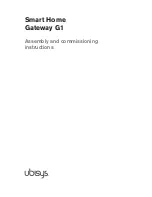
TROUBLESHOOTING
4-1
Document No.: COM-00-05-16 June 2006, Revised June 2014
Version: C.1
SECTION 4
TROUBLESHOOTING
4.0
TROUBLESHOOTING
4.1
INTRODUCTION
This section helps the user solve common problems.
4.2
DEVICES NOT TALKING TO EACH OTHER ON NETWORK
Typically, the problem is an improperly configured WAG.
If two or more WAGs are supposed to communicate with each other across the Ethernet, the UDP
port number configured in all WAGs must be the same. If one or more Slot #1 UDP port numbers
are different, that WAG cannot communicate with the other WAG using different port numbers.
There are four UDP slot numbers provided. The first UDP slot number is used by all WAGs that
need to communicate with each other. The other three are UDP port numbers that the WAG
listens to for other UDP traffic it is interested in.
Because the user can configure UDP Slot #1, many WAGs can exist on an Ethernet LAN and they
can be configured to communicate, not communicate, or to form subgroups of WAGs.
An example of this is: six WAGs on the Ethernet LAN, two of which use a UDP Slot #1 port
number of 6100, while the other four use UDP Slot #1 port number 9420. The two subgroups
cannot communicate to the other. The WAG in each subgroup can communicate among
themselves.
Check the UDP port number configuration and verify that the same port numbers are used in UDP
Slot #1. If the numbers are not the same, change the port numbers to be the same.
Ensure the broadcast medium is the same for all WAGs.
4.3
ENTRIES NOT IN ROUTING TABLE
Normally, when an expected ATCS address does not appear in the route table, there is a
communications problem between the device and the WAG. If the device has not communicated
with the WAG recently, the entry in the route table expired.
Check that twisted-pair LAN cable is secured into the connector of the Echelon device and that
the correct inputs are used.
Verify that the device not appearing in the route table is able to communicate with the WAG.
















































